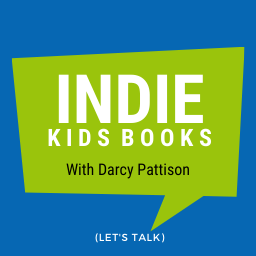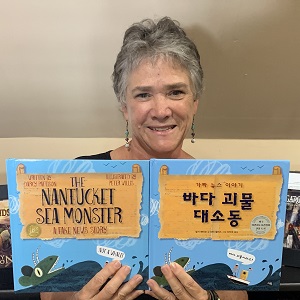Encouraging the Indie Community
ABOVE: Darcy Pattison holds the English and Korean versions of THE NANTUCKET SEA MONSTER: A Fake New Story. It was named a Junior Library Guild selection.
Increasingly, I find myself an advocate for the independently published writing community. The moniker “self-published” still carries a stigma. A self-published book, they say, is poorly writing, not edited, poorly illustrated, and has no saving graces.
Nonsense.
A self-published book just means that the author brought the book to market with a different business plan.
The legacy business plan is to license your copyright to a publisher. You might think it’s “sell your book to a publisher,” but that’s incorrect. What you’re doing is licensing your copyright, and often at terrible terms. Common licensing contracts want rights to your story for the lifetime of the copyright. Do you know how long THAT is? In the US, it’s your lifetime, plus 70 years. Forever!
For many years, that legacy contract made a kind of sense because the cost of publishing was astronomical. Besides, the publishers had the distribution network locked down, feeding into bookstores, and other venues. However, since the advent of Amazon’s Kindle ebook reader and the Print-on-Demand (POD) printers, accessibility has increased. Now, an author-publisher can enter the market with an extremely low upfront cost, usually less than $5000. It means you’re starting a small business, with just a low-risk investment upfront. Think: if you opened a storefront t-shirt shop, how much would you have to invest? Hundreds of thousands of dollars. Instead, you can put your books for sale on online markets as an ebook and POD paperback or hardcover, and your business is off and running.
So, why do self-published books look so bad? Bad business decisions.
It’s the difference between a company in business for a year and one in business for fifty years. Over time, a company learns where to invest and where to cut corners; they learn where to find their customer; they learn the business!
There’s often a glorious failure of Book 1. But when an author-publisher sticks with their business model and continues to publish, the quality of their books will inevitably rise.
In other words, discriminating against a self-published book just because it’s self-published is ridiculous. It’s based on nothing but a business practice. It says nothing about the quality of the book. Instead, let’s advocate for a good book is a good book is a good book.
Still, I prefer the term indie-publishing, which does away with that moniker and more correctly positions the individual’s publishing company within the broader market. We aren’t published by the Big 5 publisher; instead, we publish independently.
Advantages of Indie-Publishing
The biggest advantage is control of your copyright (which runs, as you remember, your lifetime plus 70 years). I have sold rights to use a title on a website, as a test passage, for translation rights (Brazil/Portuguese, Chinese, Korean), and more. Each time, I earn a fee that is 100% mine, instead of just a 10% royalty. Copyright = money. I want control.
My opinion is the one that matters. I don’t have to cater to the editors from New York, or fight for attention from an agent with 100 other clients. I write, publish, and bring to market books that I care about passionately.
Disadvantages of Indie Publishing
The buck stops here. I am the author, editor, book designer, bookkeeper, publisher, and everything else. When I make a mistake (This week, I thought I’d sent files to a reading app, so they could be on the app in a timely way, but I hadn’t—very bad!) it’s my fault.
There are few trailblazers to follow. If you write for adults, there are many who have gone before and made a fortune. For children’s book writers, there are others on the road, but the special audience makes it much harder. You have to accept risks, take a chance, try it, and when you fail, you shrug it off and go on.
As an author-publisher, I pay myself a modest salary and have fun publishing books that I love.
Have I told you about the book coming out next? (Check out the Mims House catalog!)
Let’s stop and think about what makes a good book. As an advocate for self-published or indie-published books, I can say this: the business plan says nothing about quality. Instead, let’s judge book quality on what matters: the content of the book.
IndieKidsBooks.com
I write about publishing your children’s books independently at IndieKidsBooks.com

ABOUT DARCY PATTISON
- Storyteller
- Trailblazer
- Educator
- Advocate
